- Like
- SHARE
- Digg
- Del
- Tumblr
- VKontakte
- Flattr
- Buffer
- Love This
- Save
- Odnoklassniki
- Meneame
- Blogger
- Amazon
- Yahoo Mail
- Gmail
- AOL
- Newsvine
- HackerNews
- Evernote
- MySpace
- Mail.ru
- Viadeo
- Line
- Comments
- Yummly
- SMS
- Viber
- Telegram
- JOIN
- Skype
- Facebook Messenger
- Kakao
- LiveJournal
- Yammer
- Edgar
- Fintel
- Mix
- Instapaper
- Copy Link
TL;DR: Here’s a list of our top cardio training recommendations for anyone looking to get fit at home with great results: ?
✔️ Best stationary bike: Schwinn Airdyne ($400 – 1000)⭐⭐⭐⭐⭐
✔️ Best rower: Concept2 Rower ($800 – 1200)⭐⭐⭐⭐⭐
✔️ Best elliptical: Bowflex Max Trainer ($1300 – 2000)⭐⭐⭐⭐⭐
✔️ Best stair stepper: Bowflex TreadClimber ($1300 – 2500)⭐⭐⭐⭐⭐
✔️ Best vertical climber: MaxiClimber (under $200)⭐⭐⭐⭐⭐
So You’re Thinking of Setting Up a Home Gym: Which Cardio Training Machine is Best?
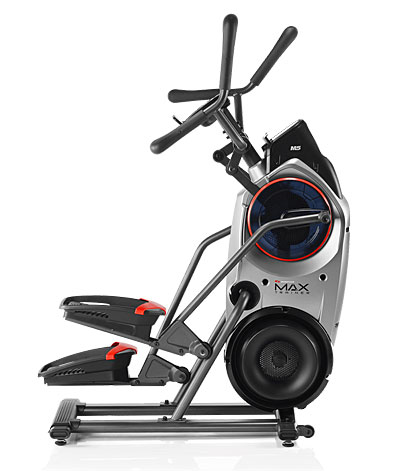
If you want to get the opinion of an experienced personal trainer on which pieces of home cardio equipment are the best use of your time and money, you’ve come to the right place.
Please know that there are many other great home cardio training options out there; my objective with the best cardio training equipment for home article is to provide an overview of some of my favorite stuff that is suited to different ability levels and personal preferences.
Before we start looking into individual machines, let’s first outline why everyone should be including some type of well-thought-out cardio training to their fitness plan. Next, I’ll help answer the most common questions about such considerations as how much cardio to do, the best types of cardio for you, and tips for setting up a home cardio training space (hint: TV is cardio’s frenemy, both helping and hindering depending on the choices you make).
The bulk of the article will, of course, go into detail on my top five best cardio training equipment for home recommendations that I feel comfortable recommending to my personal training clients, making specific recommendations about which machines may best suit your individual situation based on budget, preferences, and your individual body.
Benefits of Cardio Training
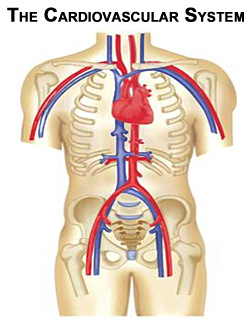 While the most highly sought-after benefit of cardio exercise is loss of excess body fat, there are several other important benefits of cardio. Cardio not only empties out your fat stores; it clears your mind, flushes out waste products, and improves basically every system in your body when correctly applied. Benefits of regular, moderate to vigorous cardio training of many different modalities include but are not limited to the following:
While the most highly sought-after benefit of cardio exercise is loss of excess body fat, there are several other important benefits of cardio. Cardio not only empties out your fat stores; it clears your mind, flushes out waste products, and improves basically every system in your body when correctly applied. Benefits of regular, moderate to vigorous cardio training of many different modalities include but are not limited to the following:
- Burning calories to help shed extra pounds of body fat
- Stronger circulatory and respiratory systems (heart, blood vessels, and lungs)
- Lower blood pressure
- Decreased risk of Type-2 (adult onset) diabetes
- Better immune function; less frequent colds & flus
- Relief from depression and anxiety symptoms, as well as prevention of relapse
- Improved metabolism and hormone balance
- Stronger, more resilient bones; prevents osteopenia and osteoporosis
Who wouldn’t want to tap into these amazing cardio exercise benefits? If you’re a beginner or novice exerciser, however, or have gotten out of shape over the years, you may very well be wondering how to structure a decent cardio plan using home cardio training equipment (or combining home training with gym training and outdoor exercise) to allow you to reap these health and fitness rewards.
Never fear! Next, I’ll break down what you need to consider about your needs, lifestyle, strengths, limitations, and fitness goals before moving on to specific equipment recommendations to suit you personally. Not every piece of equipment will be best for each individual, so there are important questions to ask yourself before making a choice.
Cardio Considerations for your Fitness Plan
How Much Cardio Should You Do?
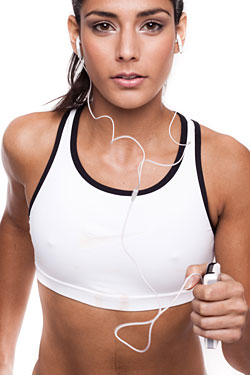 How much cardio to do, what types of cardio to include, and when you do your cardio are all important considerations when setting up a cardio plan for home or otherwise. You need to be doing not just any old cardio, but cardio that fits your specific fitness goals and fits your lifestyle.
How much cardio to do, what types of cardio to include, and when you do your cardio are all important considerations when setting up a cardio plan for home or otherwise. You need to be doing not just any old cardio, but cardio that fits your specific fitness goals and fits your lifestyle.
Basic cardio recommendations are generally as follows: for general health and wellness, adults need to do at least 90 minutes of moderate to vigorous cardio spaced out throughout the week, each and every week. If you are looking to burn body fat, you will want to dial up the frequency and possibly the duration of your cardio sessions to more like 120 minutes per week at the least.
If you’re new to exercise, 90 to 120 minutes of cardio per week might sound like a lot. But if you chunk it out and think about it as including three, four, or five shorter sessions, it will seem less overwhelming. In fact, for losing weight and improving your metabolism while maintaining your lean muscle mass, shorter, more frequent cardio is best. So there’s really no need to do marathon cardio sessions, unless of course you’re training for, well….a marathon!
Where Should You Do Cardio: Gym, Home, or Outdoors?
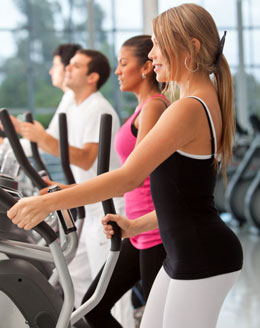 The question of the best setting for your cardio training is really just answered by your personal preferences, health considerations, and other life obligations such as work and family schedule.
The question of the best setting for your cardio training is really just answered by your personal preferences, health considerations, and other life obligations such as work and family schedule.
While there is a lot to be said for getting outside, breathing the fresh air, and soaking up some sun rays to help manufacture Vitamin D, I’m not going to claim that everyone needs to go out running or hiking frequently unless they love it and their lifestyle can accommodate it.
If you’re reading this article, I’m going to assume that you are most interested in getting your cardio exercise at home using one of several great home cardio machine options. The ideal home cardio exerciser would fit the following profile: doesn’t live or work near a gym, works odd hours, has a desire for privacy when exercising, and/or has other barriers to exercise such as a very busy work schedule or family schedule.
Additional characteristics one must have to be successful with home cardio include, perhaps most importantly, an ability to focus, work solo, and stay motivated in an often-distracting home environment. Maybe you live in an area plagued by frequent bouts of inclement weather! If most of the above sounds like you, investing in home cardio equipment may be your best option compared to joining a commercial gym or running, jogging, hiking, or biking outside.
Tips for Setting Up a Home Gym
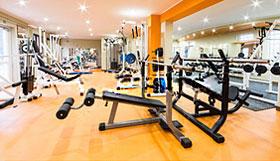 So let’s assume you have decided to invest in a piece of home cardio training equipment. Here are some tips to help you arrive at the best setup that will help ensure your success.
So let’s assume you have decided to invest in a piece of home cardio training equipment. Here are some tips to help you arrive at the best setup that will help ensure your success.
Dedicate a specific area of your home to your workouts. This can be a room all its own if you have the space, or a corner you carve out of your living room or bedroom.
Make sure you choose an area that allows you to focus and minimize distractions; don’t set up your cardio machine in too close of proximity or within a direct eye line of something that will rob your focus. An exception would be if you must motivate yourself by watching TV to zone out and actually accomplish your cardio.
If you feel you must watch TV (no judgment, though pure auditory input like music or podcasts are really better when exercising), just make sure your TV sight line is set up so that you can maintain a straight-ahead gaze and a neutral neck position while watching the TV, neither looking up nor down, nor to one side or the other. A suboptimal head position will put your neck, spine, hips, and knees at risk for injuries.
Keep your cardio area neat and tidy, swept and/or vacuumed clean and free of clutter. By all means, avoid the common trap of using your cardio machine as a coat hanger! The neater and cleaner your workout zone, and the less setup you have to do to prepare for a session, the more motivated you will be to use your equipment.
See Also:
The Top 5 Best Cardio Training Equipment for Home
Now that we’ve covered our bases on cardio programming and setup considerations, let’s dig into my top 5 favorite home cardio machines. I’ll break down what each machine does, how it works, points of difference from the others, and of course who would and wouldn’t be best suited to each machine. Without further ado, in no particular order, here are my five current favorite pieces of cardio training equipment for home.
#1. Schwinn Airdyne Bike
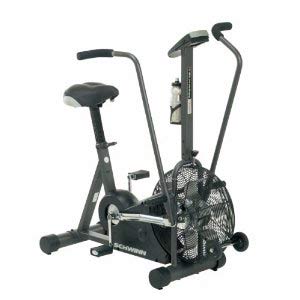 The Schwinn Airdyne Bike is an awesome piece of home cardio equipment for many reasons and so it lands on my best cardio training equipment for home list. This stationary bike has been a standby of personal trainers and home exercisers for three decades. You may not see them much in commercial gyms because the fan causes a pretty strong whooshing sound that other nearby exercisers might not appreciate. The harder you pedal, the more wind resistance is created by the fan, and the harder you will work. This allows you to adjust the workout to an appropriately challenging level by simply pedaling harder and faster or slowing it down.
The Schwinn Airdyne Bike is an awesome piece of home cardio equipment for many reasons and so it lands on my best cardio training equipment for home list. This stationary bike has been a standby of personal trainers and home exercisers for three decades. You may not see them much in commercial gyms because the fan causes a pretty strong whooshing sound that other nearby exercisers might not appreciate. The harder you pedal, the more wind resistance is created by the fan, and the harder you will work. This allows you to adjust the workout to an appropriately challenging level by simply pedaling harder and faster or slowing it down.
The Schwinn Airdyne Bike allows you to get a vigorous fat-burning cardio workout. In addition to the expected foot pedals, there are also handles up top that you can choose to push with your arms and chest to effectively get your upper body muscles into the mix. Or you can even just use your arms if you want to give them more attention (or give your legs a break). This is pretty rare in a stationary bike, most of which limit you to only using your lower body. I also really appreciate the durable construction of the Schwinn Airdyne as well as the long warranty period on the frame, which on some models goes as high as 30 years!
I’d recommend the Schwinn Airdyne bike for exercisers that enjoy biking and don’t have trouble pushing themselves to up the intensity, since the intensity of the Schwinn Airdyne Bike workout is dependent on how hard and fast you are pedaling, rather than the machine guiding you through. This bike is great for toning up upper and lower body muscles and burning lots of calories for effective fat loss.
Further Reading:
#2. Concept2 Rower
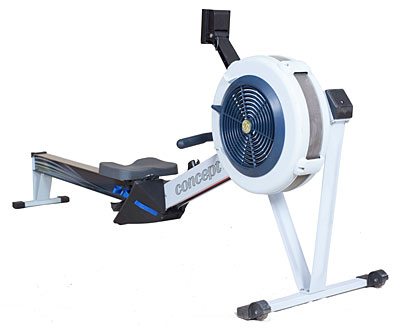 My top 5 best cardio training equipment for home list wouldn’t be complete without the inclusion of the classic Concept2 Rower. The Concept2 Rower is found in most commercial gyms as well as lots of home gyms for many good reasons. The first reason is that rowing is just an all-around excellent cardio training workout! You might not immediately associate rowing with intense cardio, but give it a shot and then get back to me! You’ll be surprised by the intensity you can achieve as well as the pleasant feeling you get from gliding back and forth, pushing with your legs and pulling with your arms and back.
My top 5 best cardio training equipment for home list wouldn’t be complete without the inclusion of the classic Concept2 Rower. The Concept2 Rower is found in most commercial gyms as well as lots of home gyms for many good reasons. The first reason is that rowing is just an all-around excellent cardio training workout! You might not immediately associate rowing with intense cardio, but give it a shot and then get back to me! You’ll be surprised by the intensity you can achieve as well as the pleasant feeling you get from gliding back and forth, pushing with your legs and pulling with your arms and back.
I really love that rowing on the Concept2 strengthens your arms, hips and legs, core, and especially your lats and midback. Executed properly, rowing is excellent for your posture and is a considered a highly functional exercise.
As an effective full body exercise, rowing is great for melting away excess pound of body fat. Many regular rowers have reported fast and sustainable weight loss. Since rowing strengthens so many muscles, it also preserves and builds lean muscle mass, which improves your baseline metabolism
The Concept2 is an extraordinarily solidly built piece of equipment, requiring very little maintenance beyond oiling the chain with as substance as basic and cheap as food-grade mineral oil. You can expect an initial investment of at least $1000 depending on the Concept2 model you buy, but I consider it money very well spent on a solid, efficient, and fun piece of home cardio equipment.
Be sure to test a rower before purchasing to ensure that it will work for your body. Though most people throughout all age groups do very well with a rowing workout, folks with particularly bad backs or knees may find that leaning forward from the trunk and/or bending the knees and pushing with the legs in a seated position is troublesome to their joint issues.
Further Reading:
#3. Bowflex Max Trainer
 For fairly healthy exercisers with a decent baseline level of fitness, the Bowflex Max Trainer is an excellent addition to your home gym. The Max Trainer is pretty intense, built around the principles of high-intensity interval training.
For fairly healthy exercisers with a decent baseline level of fitness, the Bowflex Max Trainer is an excellent addition to your home gym. The Max Trainer is pretty intense, built around the principles of high-intensity interval training.
The Bowflex Max Trainer machine combines the benefits of a stair stepper and a elliptical, allowing you to wail on your legs, glutes, core, arms, and chest to get your heart pumping and the sweat pouring.
Bowflex products are not cheap, but they are effective, innovative, and well-built, so they can be a great choice depending on how much money you are willing to lay down.
Those who are quite deconditioned or who have bad hips, knees, or backs will do better to choose a less-demanding machine such as the Concept2 Rower, Schwinn Airdyne Bike, or Bowflex TreadClimber.
Further Reading:
#4. Bowflex TreadClimber
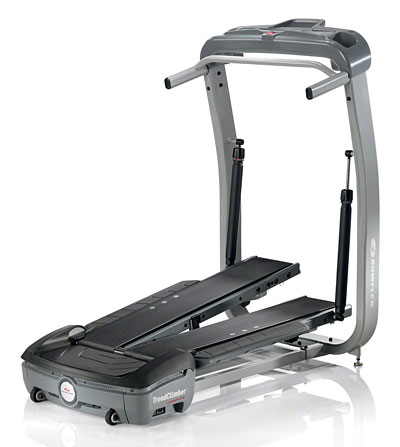 The slogan of the Bowflex TreadClimber is “Just Walk”. If you can walk, you should be able to safely and effectively use this piece of home cardio equipment. The TreadClimber has two independently-moving mini-treadmill belt pedals that spring up with your every step, allowing you to mimic the motion of hillclimbing, which is excellent for burning calories as well as toning up your butt and legs.
The slogan of the Bowflex TreadClimber is “Just Walk”. If you can walk, you should be able to safely and effectively use this piece of home cardio equipment. The TreadClimber has two independently-moving mini-treadmill belt pedals that spring up with your every step, allowing you to mimic the motion of hillclimbing, which is excellent for burning calories as well as toning up your butt and legs.
If you love a walking-style workout but want more bang for your buck than walking on a treadmill or walking outside, the TreadClimber is an awesome choice. Just know that no TreadClimber model goes faster than 4.5 miles per hour, so joggers and runners need not apply. However, due to the fast hillclimbing motion you’ll hit, you don’t need to jog or run to get a great cardio workout on the Bowflex TreadClimber.
I like this home cardio machine option for folks that like to walk, don’t mind putting in a fair amount of time on the machine to get results, and most importantly, for those who have joint issues or health considerations that may preclude the safe use of more intense machines such as the Bowflex Max Trainer or Concept 2 Rower.
Further Reading:
#5. Maxi Climber Vertical Climber: Budget-Friendly Superstar!
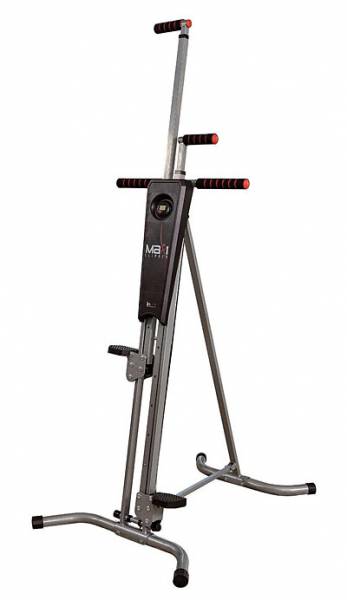 The final piece of home cardio training equipment to land on my top 5 best cardio training equipment for home list is the Maxi Climber Vertical Climber. I like the function and I LOVE the price point and convenience; you can pick up a Maxi Climber for just a couple hundred bucks. It’s a pretty simple machine that arrives 90% assembled. It also folds up between uses, making it the most friendly for small spaces. It’s also pretty quiet during operation, which can’t exactly be said about all cardio equipment out there.
The final piece of home cardio training equipment to land on my top 5 best cardio training equipment for home list is the Maxi Climber Vertical Climber. I like the function and I LOVE the price point and convenience; you can pick up a Maxi Climber for just a couple hundred bucks. It’s a pretty simple machine that arrives 90% assembled. It also folds up between uses, making it the most friendly for small spaces. It’s also pretty quiet during operation, which can’t exactly be said about all cardio equipment out there.
The Maxi Climber is sort of like a stair stepper, and sort of like rock climbing. You’ll be using your legs and arms to power your workout. You can choose to employ more arms and less legs or vice versa depending on which body parts you would like to emphasize. Though the resistance is not adjustable, you can adjust the depth of your steps as well as your speed to make your workout more or less intense. This machine is great for interval training. It’s also adjustable to comfortably fit different body dimensions from short folks up through tall folks.
Similar to the Schwinn Airdyne Bike, the Maxi Climber Vertical Climber machine leaves you in charge of how hard you choose to work, so you’ll need to dig in and find your own motivation to push yourself rather than relying on the rhythm of a programmed machine to push you.
Those with hip, knee, back, and/or shoulder problems would do better with a gentler machine. But if you have a healthy kinetic chain and a tight budget, the Maxi Climber is the way to go.
Top Five Best Cardio Training Equipment for Home: The Trainer’s Takeaway
So there you have my top shortlist of the best cardio training equipment for home. All of these machines are ones I have recommended to my personal training clients who wish to add a home cardio training component to their fitness program.
My goal was to include options that fit well with different budgets, fitness levels, and exercise preferences, so I hope you found information that helps guide you to the right choice for your home gym.
See Also:
About Michael Behnken
Mike Behnken is a personal trainer who holds multiple NASM certifications and a MS in Exercise Science. Mike loves fitness, travel, and photography among many other interests.
